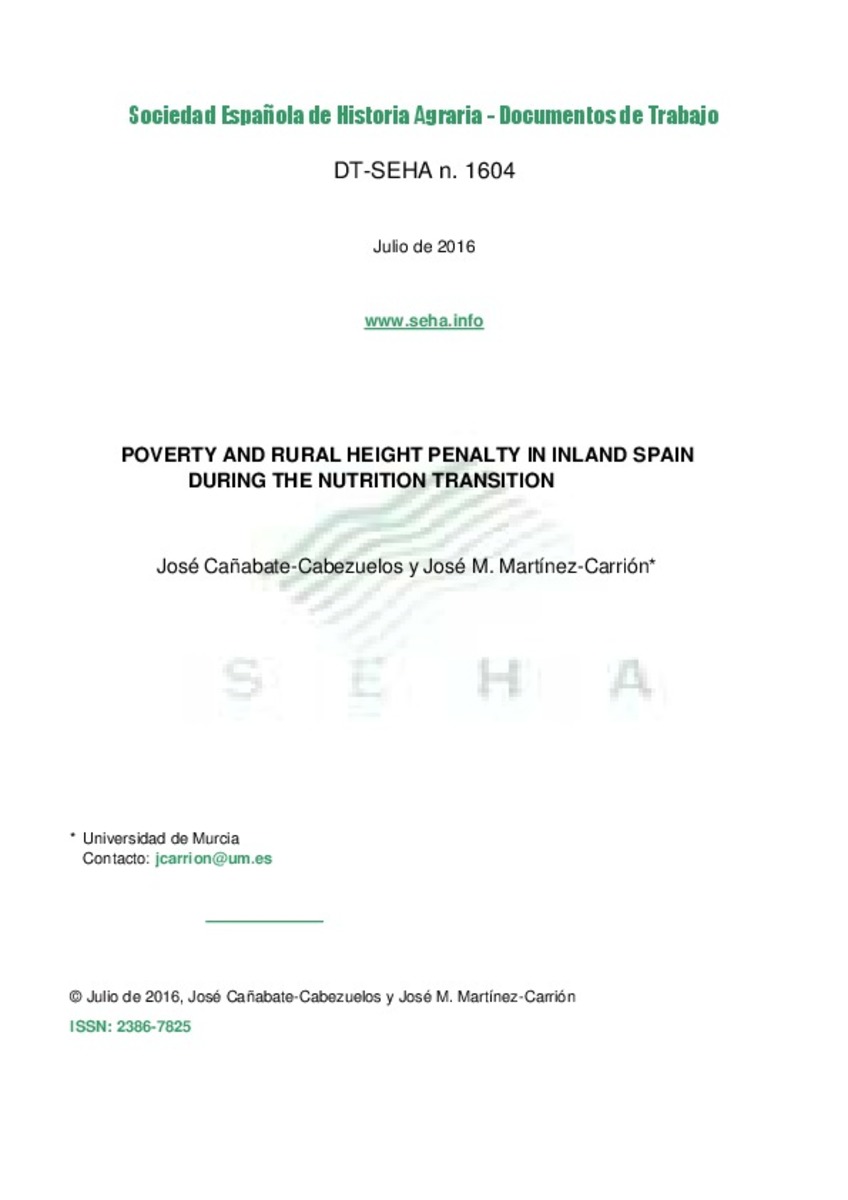Mostrar el registro sencillo del ítem
Poverty and rural height penalty in inland Spain during the nutrition transition
| dc.contributor.author | Cañabate Cabezuelos, José | |
| dc.contributor.author | Martínez-Carrión, José Miguel | |
| dc.date.accessioned | 2016-07-18T07:25:15Z | |
| dc.date.available | 2016-07-18T07:25:15Z | |
| dc.date.issued | 2016-07 | |
| dc.identifier.issn | 2386-7825 | |
| dc.identifier.uri | http://hdl.handle.net/10234/161735 | |
| dc.description.abstract | The article analyses nutritional inequalities and stunting in inner rural Spain from a case study carried out in Castile-La Mancha. The examination of the height of military draftees explores the gap between urban and rural populations and analyses the evolution of growth patterns in different habitational contexts. The results indicate that stunted growth and undernourishment were pervasive in the two initial decades of the 20th century, that the situation improved slightly in the 1920s and the first half of the 1930s, and that in the 1940s and 1950s the conditions again deteriorated considerably. Stunted growth was significant especially in rural areas, which were particularly penalized during Francoism. Height increased considerably in the 1960s and 1970s and although this improvement also reached the rural areas the gap that separated the countryside and the urban areas did not disappear until the early 1980s. The data suggests that a poor and limited diet, the economic policies and the social assistance-related institutional framework were key factors in the evolution of growth. Finally, the results also stress the need to extend the study to adolescent circumstances, and not only children, as well as the need to investigate social inequality among different professional groups during the nutritional transition. | ca_CA |
| dc.description.abstract | Este artículo analiza la desigualdad nutricional y la baja talla en la España interior a partir de un estudio de caso en Castilla-La Mancha. Con tallas de los quintos explora la brecha rural-urbana del estado nutricional y comprueba el alcance del crecimiento en los diferentes ambientes residenciales. Los resultados muestran la prevalencia de tallas bajas y malnutrición en las dos primeras décadas del siglo XX, un ligero avance en la década de 1920 y primera mitad de 1930, y un deterioro de la nutrición neta en las décadas de 1940-50. El retraso del crecimiento o desmedro, baja talla para la edad, fue mayormente significativo en las áreas rurales, que acusaron una mayor penalización durante el franquismo. El crecimiento de la talla fue sustancial en las décadas de 1960-70 y, aunque fue notorio en las zonas rurales desde 1968, la brecha con el mundo urbano se mantuvo hasta 1980. Concluye que las privaciones y la pobreza de la dieta, las políticas económicas y el marco institucional en la provisión de servicios asistenciales fueron factores decisivos del crecimiento. Finalmente, los resultados sugieren tener en cuenta el ambiente de la adolescencia, además del de la infancia, y avanzar en la investigación sobre la desigualdad social por grupos ocupacionales durante la transición nutricional. | ca_CA |
| dc.format.extent | 34 p. | ca_CA |
| dc.format.mimetype | application/pdf | ca_CA |
| dc.language.iso | eng | ca_CA |
| dc.publisher | Sociedad Española de Historia Agraria | ca_CA |
| dc.relation.isPartOfSeries | Documentos de Trabajo; 16-04 | |
| dc.rights | © Julio de 2016, José Cañabate-Cabezuelos y José M. Martínez-Carrión | ca_CA |
| dc.rights.uri | http://rightsstatements.org/vocab/InC/1.0/ | * |
| dc.subject | height | ca_CA |
| dc.subject | stunting | ca_CA |
| dc.subject | rural poverty | ca_CA |
| dc.subject | nutrition transition | ca_CA |
| dc.subject | Spain | ca_CA |
| dc.subject | estatura | ca_CA |
| dc.subject | desmedro | ca_CA |
| dc.subject | pobreza rural | ca_CA |
| dc.subject | transición nutricional | ca_CA |
| dc.subject | España | ca_CA |
| dc.title | Poverty and rural height penalty in inland Spain during the nutrition transition | ca_CA |
| dc.type | info:eu-repo/semantics/workingPaper | ca_CA |
| dc.subject.jel | D63 | ca_CA |
| dc.subject.jel | I14 | ca_CA |
| dc.subject.jel | I32 | ca_CA |
| dc.subject.jel | N34 | ca_CA |
| dc.rights.accessRights | info:eu-repo/semantics/openAccess | ca_CA |
Ficheros en el ítem
Este ítem aparece en la(s) siguiente(s) colección(ones)
-
DT_SEHA [101]
Documentos de Trabajo de SEHA







